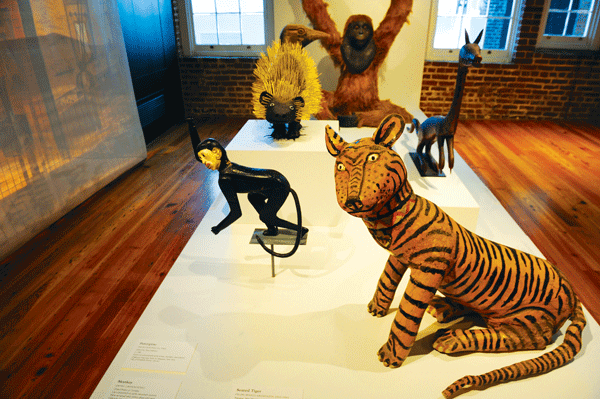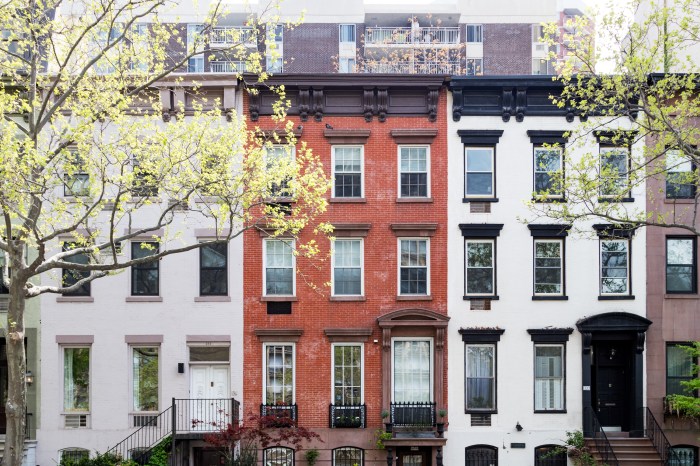
BY TERESE LOEB KREUZER | A beautifully painted map of the world showing animals native to each continent and a collection of quirky, carved animals greet visitors to “Compass: Folk Art in Four Directions,” an exhibit that will be on view at the South Street Seaport Museum through early October.
The exhibit, inspired by New York City’s maritime history, draws from the collection of the American Folk Art Museum, the show’s producer. Few of the items on display were actually made in New York, but most date from the 19th century, when the East River was bustling with ferries connecting Manhattan and Brooklyn and with sailing ships that traded all over the world.
In four galleries, the exhibit meditates on exploration, social networking, shopping and the environmental conditions that affected sea-going life.
The young girl from New England, who in 1835 made a detailed map of the world displaying the animals of each region, would likely not have been able to see the places that she imagined.
“The people aboard the ships were ordinary men who got to see extraordinary things as they traveled the globe,” explained Stacey Hollander, senior curator for the American Folk Art Museum.
The exhibit shows portraits of the men who went to sea and the women who waited for them to come home. Mercantile voyages often took three to five years, and some of the men never came back.
One of the paintings by a young woman named Jane Otis Prior mourns the 1815 death of her father, Captain Matthew Prior, and her older brother, Barker Prior, who was lost at sea. Another painting from around 1845 of a toddler next to a barren tree stump records the death of a little girl who died while her father was away.
The second of the four galleries deals with social networking and was inspired by 19th-century graffiti on the wall of the South Street Seaport Museum itself. The graffiti dates from a time when the buildings of Schermerhorn Row that now house the maritime museum harbored several seamen’s hotels and a coffee-and-tea trader.
This led Hollander to delve into the American Folk Art Museum’s collection for artifacts relating to coffeehouses, which were places where business was conducted and where people went to relax and to discuss important political issues.
An 1832 signboard for a coffeehouse in Massachusetts is also prominent in this gallery. On its reverse, it shows a well-stocked shop. “There’s always been a strong association between the consumption of teas and coffees, and shopping,” said Hollander.
For the social networking gallery, Hollander came up with account books, a checkerboard and carved dioramas of people playing cards. An expressive carving of a newsboy puffing on a cigar advertises the pleasures of smoking. At the time, coffeehouse air would have been dense with smoke from cigars, pipes and cigarettes. Snuff, which was also popular, is exhibited in the form of a large, salt-glazed snuff jar.
One of the most interesting objects in this gallery is a folding chair made by Hosea Hayden, a 19th-century farmer from Indiana. The ingenious chair is portable and can be carried by its handle. Hayden made the first of a dozen similar chairs in 1883 to celebrate his father’s 100th birthday, but what is equally interesting is that he inscribed every surface with drawings and with his own thoughts about science, religion and women’s suffrage.
Hollander said that Hayden’s inscriptions reminded her of the graffiti on the wall of the room in which the chair is on display. “He was a free thinker,” she said.
The third gallery has to do with shopping, which Hollander spoke to by saying that commercial activities have been a part of the Seaport’s history from the get-go. “The East River was a natural harbor for smaller sailing vessels that were engaged in international trade,” she said. “Urban centers like New York became tastemakers for the entire country.”
Also on display are fancy goods such as woven coverlets, which were commissioned from professional weavers; portraits of fashionably dressed women; children with expensive dollhouses and other toys; and elaborate furniture painted with scenes of local landscapes or embellished with gold-leafed designs.
East River commerce also took place between the then-independent cities of Manhattan and Brooklyn. An 1848 painting in this gallery shows Manhattan, a city of small buildings, as viewed from a ferry dock on the Brooklyn side of the river. Only City Hall and a few church spires rose above the skyline.
The fourth and final gallery explores the weather that shapes maritime environments and the change from sailing ships to steam ships that forced wood carvers to find new markets for their work.
For this gallery, Hollander selected some notable statuary of wooden figurines that would have been positioned outside tobacconists’ shops to attract customers in the 19th century. Some of the tobacconist statuary was carved in New York City workshops that once created figureheads for sailing ships. The workshop of Samuel Anderson Robb, first situated on Canal Street and later on Centre Street, was particularly renowned.
The American Folk Art Museum curatorial staff is hosting a talk about the Compass exhibit on Mon., July 2 at 1 p.m. as part of the River to River Festival at the Seaport Museum. Tours of the exhibit, conducted by American Folk Art Museum educators, will be offered on Wednesdays at 1 p.m. between July 11 and Sept. 26.
The South Street Seaport Museum, located at 12 Fulton St., is open daily from 10 a.m. to 6 p.m. Adult admission is $10; for seniors and students, admission is $6. Members of the Museum of the City of New York and the South Street Seaport Museum are admitted free of charge, as are all children under age 9. For more information, visit https://www.southstreetseaportmuseum.org/Default.asp

















